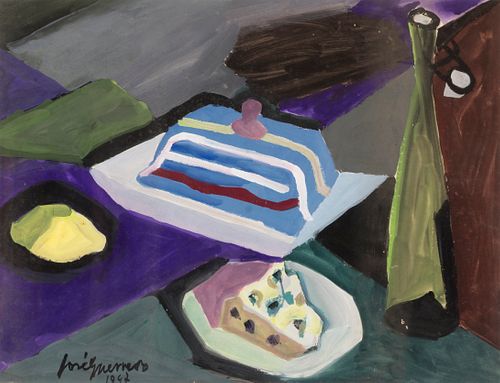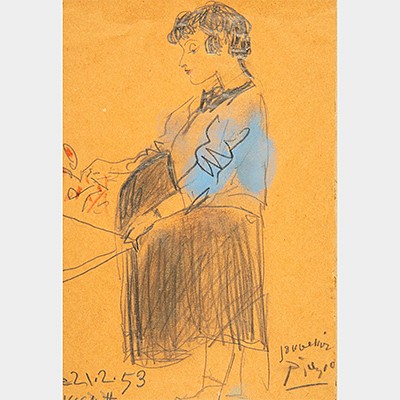JOSÉ GUERRERO (Granada, 1914 - Barcelona, 1991). "El desayuno / Naturaleza muerta con mesa puesta (Stilleben mit gedecktem Tisch) (Breakfast / Still L
Lot 89
About Seller
Setdart Auction House
Carrer Aragó 346
Barcelona
Spain
Setdart Subastas was born in 2004 and is currently the first online art auction in Spain with solidity, prestige and reliability guaranteed by our more than 60,000 users. Setdart has a young, dynamic and enterprising team ready to successfully manage the purchase and sale of art works through custom...Read more
Categories
Estimate:
EUR€9,000 - EUR€10,000
$9,677.42 - $10,752.69
Absentee vs Live bid
Two ways to bid:
- Leave a max absentee bid and the platform will bid on your behalf up to your maximum bid during the live auction.
- Bid live during the auction and your bids will be submitted real-time to the auctioneer.
Bid Increments
| Price | Bid Increment |
|---|---|
| EUR€0 | EUR€10 |
| EUR€200 | EUR€25 |
| EUR€500 | EUR€50 |
| EUR€1,000 | EUR€100 |
| EUR€3,000 | EUR€200 |
| EUR€5,000 | EUR€500 |
| EUR€10,000 | EUR€1,000 |
| EUR€20,000 | EUR€2,000 |
| EUR€50,000 | EUR€5,000 |
About Auction
By Setdart Auction House
Sep 20, 2021
Set Reminder
2021-09-20 08:00:00
2021-09-20 08:00:00
America/New_York
Bidsquare
Bidsquare : CONTEMPORARY ART
https://www.bidsquare.com/auctions/setdart-auction-house/contemporary-art-7482
Setdart Auction House sofia@setdart.com
Setdart Auction House sofia@setdart.com
- Lot Description
JOSÉ GUERRERO (Granada, 1914 - Barcelona, 1991). "El desayuno / Naturaleza muerta con mesa puesta (Stilleben mit gedecktem Tisch) (Breakfast / Still Life with Table Set (Stilleben mit gedecktem Tisch)), 1947. Gouache on paper. Work reproduced in the Catalogue Raisonné of the artist: Nº 74 p.229. Exhibited in: José Guerrero. The early years: 1931-1950. José Guerrero Centre Granada (2008-09). Provenance: Tony Grieb Collection. Signed and dated in the lower left corner. Measurements: 39 x 50.5 cm; 63 x 75 cm (frame). In 1947 José Guerrero was in Rome, where he lived until 1948. Although he did not officially train at the Spanish Academy in Rome, during his stay in the city he painted a group of works which were exhibited in the Galleria del Secolo. Despite being a relatively early work, the artist's mastery in the use of tonalities can already be appreciated, playing with complementary colours and dividing the space into geometric shapes defined as a field of colour, which, in contact with the others, acquire depth thanks to the tone. A Spanish painter and engraver who became a naturalised American citizen, José Guerrero developed his work within abstract expressionism. He began his training at the School of Arts and Crafts in Granada, and soon moved to Madrid to continue his studies at the San Fernando School of Fine Arts, where he was a pupil of Daniel Vázquez Díaz, who recommended that he continue his academic training in New York. In 1942 he obtained a scholarship from the Casa de Velázquez, and in 1945 he moved to Paris thanks to a new scholarship, this time awarded by the French government. In the French capital he became acquainted at first hand with the European avant-garde and came into contact with the Spanish painters of the School of Paris. In the 1950s he discovered the abstract expressionism of the New York school. After studying English in London, Guerrero moved to New York in 1950, encouraged by his wife, the New York journalist Roxana Pollock, whom he had married a year earlier. In 1954 he exhibited with Joan Miró at the Art Club of Chicago, an exhibition that marked his definitive international projection. His dealer was Betty Parsons, one of the most important gallery owners in New York at the time, and a gallery owner of important artists such as Pollock, Rothko, Clifford Still and Barnett Newman. During his stay in America Guerrero's style changed completely, showing a profound influence of Rothko and Kline; he definitively abandoned figuration and constructed compositions in which a marked tension between spaces, colours and unrecognisable objects was evident. He returned to Spain in 1965 and took part in the creation of the Museum of Abstract Art in Cuenca. He soon returned to New York, although he continued to make trips to Spain. His production, which continues to be characterised by the power of masses of colour, planes and lines, was at this time influenced to some extent by Clyfford Still and Barnett Newman. José Guerrero is now recognised as one of the most outstanding Spanish painters of the New York School. He achieved early recognition, being named Chevalier de l'Ordre des Arts et des Lettres by the French government in 1959. His first anthological exhibition was held in his native city in 1976. In 1984 he was awarded the Gold Medal of Fine Arts, and in 1989 he was decorated by the Rodríguez Acosta Foundation.
- Shipping Info
-
In-house shipping available. Please inquire at admin@setdart.com.
-
- Buyer's Premium



 EUR
EUR CAD
CAD AUD
AUD GBP
GBP MXN
MXN HKD
HKD CNY
CNY MYR
MYR SEK
SEK SGD
SGD CHF
CHF THB
THB

















